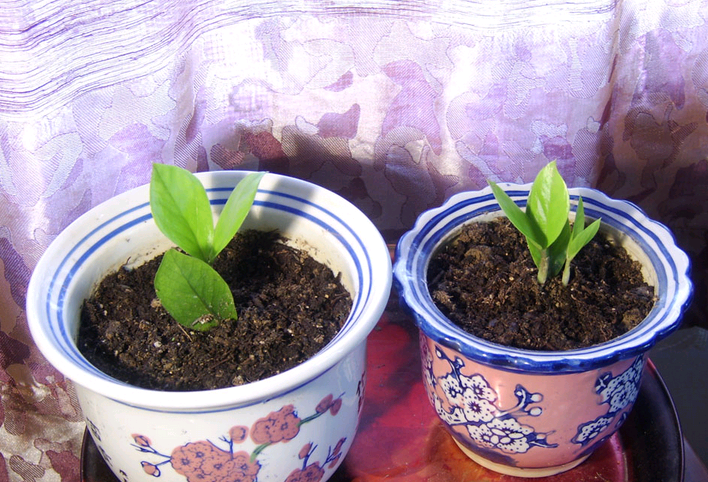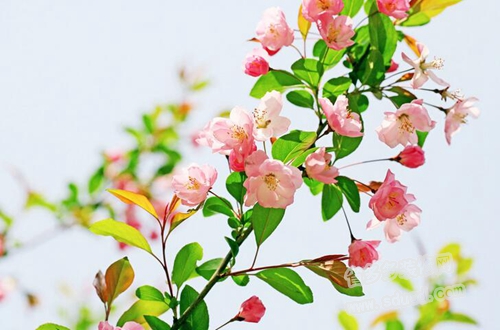Why is it difficult for money tree cutting to take root and survive?
How to raise the money tree? Give you a book, "868 tips for growing flowers", and never worry about raising a good money tree any more! How do I get this book?
Lixiayuanyi
↑ long press copy → to open Wechat → point upper right corner "+" → point add friend → paste and search → shows "the user does not exist" under the "search" → click the first and follow → reply "money tree" will get.
The main reason why it is not easy to take root and survive is that we fail to master the feasible cutting methods. It is suitable for cutting from April to May or from September to October, and the temperature is about 20-25 ℃.
After 20-30 days, the base of cuttings can form healing tissue and differentiate into roots, and then slowly form inflated tubers.
The pinnately compound leaves can not be sprouted on the tuber until 10 months later. Soaking the base of cuttings with 100mg / L indolebutyric acid or No. 1 ABT rooting powder for 3-5 seconds could promote rooting and facilitate the formation of adventitious buds. After a single leaf was cut in vermiculite, a small bulb with fleshy root could be formed at the base of the petiole after about 10 to 14 days, and then the corm expanded continuously and latent buds grew on the corm. After 2-3 months of culture and maintaining the ambient temperature of 25-30 ℃, pinnate leaves could grow into plantlets.
How long can the cuttings of Artemisia angustifolia take root? four kinds of techniques to improve rooting

How long will it take for the cuttings to take root?
How long does it take to take root in general cutting propagation? if you use a reasonable and correct cutting method, it will take about 15 minutes to take root in 20 days.
When cutting, we must choose strong plants as cuttings. The cutting time is generally from April to May or from September to October, and the temperature is about 20-25 ℃. At this time, it takes only 15 minutes and 20 days to let the new roots of the tree sprout.
Let the rapid rooting skills of cutting money tree 1. Cutting at about 20 degrees
2. Soak in rooting water
The secret of most flower friends' cuttings to take root and survive easily is that they soak the base of the cuttings with rooting water before cutting, disinfect and sterilize them, and can also promote the germination of the root system. It is suggested that soaking the base of cuttings with 100mg / L indolebutyric acid or No. 1 ABT rooting powder for 5 seconds can promote rooting and is beneficial to the formation of adventitious buds.
If it is difficult to take root, it can be diluted 30 times and 50 times, and dipped in it for 6 seconds. If it is easy to take root, it will be diluted 100 times and 150 times, and it will be dipped in 3 Mel for 6 seconds.
3. Put on the fresh-keeping film to keep moisture.
Flower friends find that even if they are soaked in rooting water, the cuttings of the money tree will not take root soon, then you may lack this important step, that is, using plastic film to cover the cuttings of the money tree, it can keep the water in the potted soil from losing and play the role of moisturizing, because in the process of rooting, it can neither lack nor accumulate water, and the effect of plastic film is just in line with the water needs of rooting. It can also reduce the number of times of spraying water during the cutting of money tree.
4. Prevent maintenance in the shade
The novice cuttings money tree, thinking that the money tree needs more sun to take root, in fact, it is not, because the money tree that has just been cut has no root, if it is exposed to the sun immediately, it will lead to the death of the money tree cuttings, let alone take root. we should keep the money tree in a ventilated and cool place for about 20 days, and the roots will germinate more easily in low light.
Cutting propagation methods and matters needing attention of Artemisia angustifolia
The method of cutting propagation of Artemisia mandshurica 1. Cutting soil
The cutting soil can be mixed with river sand and vermiculite, or the soil mixed with fine sand, peat soil, perlite and river sand at 3:1:1.
2. Selection of cuttings
Flower friends can choose a single leaf, a leaf axis plus two leaves, or a single leaf axis.
Generally speaking, in terms of rooting effect, cuttings with leaves on leaf axis have fast rooting speed and high sprouting rate, and it is easier to open into larger tubers.
In general, a single leaf needs to go through 10 to 14 days, and a rooting bulb can be formed at the base of the leaf. After 2 to 3 months of cultivation, it can grow into a small plant, but the seedling rate is not high in general.
3. Cutting method
The cutting method of Artemisia mandshurica is simple. Flower friends can directly put the cuttings into the soil with the depth of ear length, leaving only the leaves outside the substrate, spray them in a shaded place after spraying through water, maintain the ambient temperature of 25 ℃ ~ 27 ℃, and spray the leaves once or twice a day depending on the dryness and humidity of the substrate.
Keep the substrate slightly moist and must not be too wet, otherwise it will cause cuttings to rot and lead to cuttings failure.
4. Matters needing attention in cutting
The soil used for cutting should not be too wet, which can easily cause cuttings to rot. When the cuttings form a certain root system, the middle of the root gradually expands to form a globular tuber, and the tuber increases gradually.
Some of the tender cutting leaves will wither and die due to high temperature or poor water management, but the tubers can survive, and the old mature leaves and cuttings with total petiole can also remain green and vigorous.
A small number of tubers can sprout and grow new leaves in the same year, but the growth is weak and slow, and the tubers grow sturdy new buds and grow normally the next year.
- Prev

How to maintain the happiness tree?
Alias chili tree, elbow umbrella, mountain happiness tree. Trade name: happiness Tree, Kirin Ziwei. Native to China's Taiwan, Hainan, Yunnan, Guizhou, Guangdong, Guangxi 300m valley or plain sparse woodland. Trees, bipinnately compound, leaflets ovate, 4-7 cm long, apex caudate
- Next

How many kinds of crabapple flowers are there? How to maintain and manage?
Begonia is native to China and is widely cultivated in the north of the Yangtze River valley. It has a long history and is a traditional famous flower in China. There is no lack of planting in classical gardens, often forming independent scenic spots, in the name of flowers, such as "Begonia Chunwu". Architectural decoration also often uses begonia pattern to design doors and windows, walls and roads, which can be seen everywhere, giving people the enjoyment of beauty.
Related
- Fuxing push coffee new agricultural production and marketing class: lack of small-scale processing plants
- Jujube rice field leisure farm deep ploughing Yilan for five years to create a space for organic food and play
- Nongyu Farm-A trial of organic papaya for brave women with advanced technology
- Four points for attention in the prevention and control of diseases and insect pests of edible fungi
- How to add nutrient solution to Edible Fungi
- Is there any good way to control edible fungus mites?
- Open Inoculation Technology of Edible Fungi
- Is there any clever way to use fertilizer for edible fungus in winter?
- What agents are used to kill the pathogens of edible fungi in the mushroom shed?
- Rapid drying of Edible Fungi

